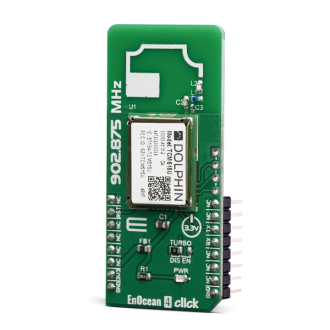
We strongly encourage users to use Package manager for sharing their code on Libstock website, because it boosts your efficiency and leaves the end user with no room for error. [more info]

Rating:
Author: MIKROE
Last Updated: 2019-07-17
Package Version: 1.0.0.0
mikroSDK Library: 1.0.0.0
Category: Sub-1 GHz Transceivers
Downloaded: 3988 times
Not followed.
License: MIT license
EnOcean 4 Click carries a ultra-low power TCM515U transceiver gateway module which operates at 902MHz radio band, perfectly suited for the realization of transceiver gateways, actuators and controllers for systems communicating based on the EnOcean radio standard.
Do you want to subscribe in order to receive notifications regarding "EnOcean 4 click" changes.
Do you want to unsubscribe in order to stop receiving notifications regarding "EnOcean 4 click" changes.
Do you want to report abuse regarding "EnOcean 4 click".


Library Description
This library allows user to perform an ESP3 (EnOcean Serial Protocol 3) communication. User can send packet data, which can consist of the commands, telegrams, messages... The library also can be used to check the response from the modul. When the response is ready, the library sets a flag. For more details check documentation.
Key functions:
T_ENOCEAN4_RETVAL enocean4_procces( void )- This function performs a response proccesing and calls handler function if response is valid.T_ENOCEAN4_RETVAL enocean4_responseReady( void )- This function checks the response ready flag and if flag is set, clears a flag.T_ENOCEAN4_RETVAL enocean4_sendPacket( T_enocean4_packet *packet )- This function allows user to send a valid packet data to the module by using UART interface.Examples description
The application is composed of three sections :
void applicationTask()
{
if (device_mode == RECEIVER)
{
mikrobus_logWrite( "Telegram receiving...", _LOG_LINE );
checkResponse();
mikrobus_logWrite( "***********************************", _LOG_LINE );
Delay_ms( 5000 );
mikrobus_logWrite( "Telegram sending...", _LOG_LINE );
sendTelegram( &_answer1[0], _ENOCEAN4_RORG_ADT );
checkResponse();
mikrobus_logWrite( "***********************************", _LOG_LINE );
mikrobus_logWrite( "Telegram receiving...", _LOG_LINE );
checkResponse();
mikrobus_logWrite( "***********************************", _LOG_LINE );
Delay_ms( 5000 );
mikrobus_logWrite( "Telegram sending...", _LOG_LINE );
sendTelegram( &_answer2[0], _ENOCEAN4_RORG_ADT );
checkResponse();
mikrobus_logWrite( "***********************************", _LOG_LINE );
}
else if (device_mode == TRANSMITTER)
{
mikrobus_logWrite( "Telegram sending...", _LOG_LINE );
sendTelegram( &_message1[0], _ENOCEAN4_RORG_ADT );
checkResponse();
mikrobus_logWrite( "***********************************", _LOG_LINE );
mikrobus_logWrite( "Telegram receiving...", _LOG_LINE );
checkResponse();
mikrobus_logWrite( "***********************************", _LOG_LINE );
Delay_ms( 5000 );
mikrobus_logWrite( "Telegram sending...", _LOG_LINE );
sendTelegram( &_message2[0], _ENOCEAN4_RORG_ADT );
checkResponse();
mikrobus_logWrite( "***********************************", _LOG_LINE );
mikrobus_logWrite( "Telegram receiving...", _LOG_LINE );
checkResponse();
mikrobus_logWrite( "***********************************", _LOG_LINE );
Delay_ms( 5000 );
}
}
Additional Functions :
Other mikroE Libraries used in the example:
Additional notes and informations
Depending on the development board you are using, you may need USB UART click, USB UART 2 click or RS232 click to connect to your PC, for development systems with no UART to USB interface available on the board. The terminal available in all MikroElektronika compilers, or any other terminal application of your choice, can be used to read the message.